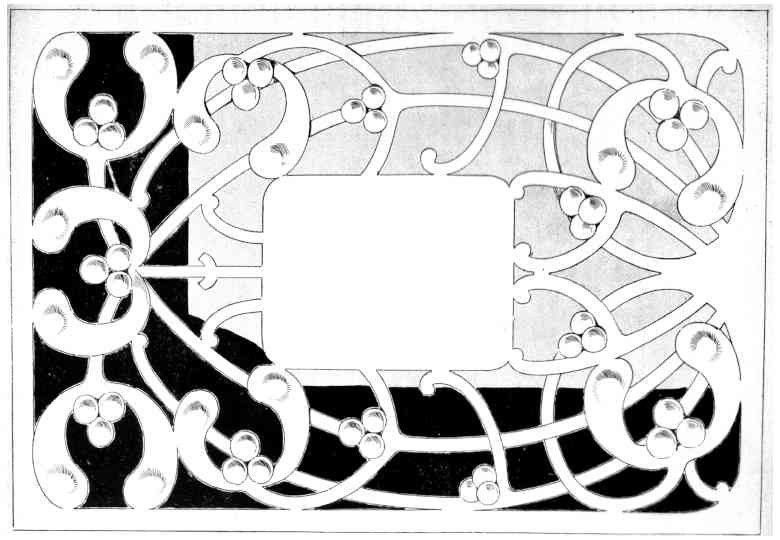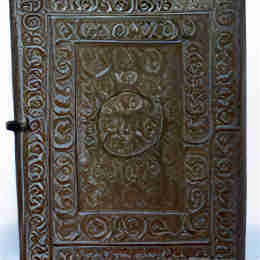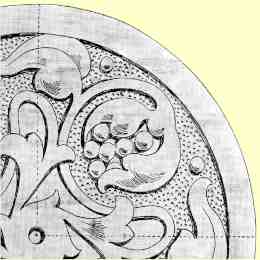Vintage metal work embossed book cover idea
This metal work series continues on from last month's investigation into creating your own antique metal cabinet hinges or three designs. Part 3 described practical designs for metal work that featured a simple floral pattern, a classic square leaf pattern and an ornate circular pattern. Metal work part 4 builds in complexity by demonstrating metal work embossing techniques for an original and very ornate book cover for your personal diary or other bound heirloom.

Lessons in Metal Work.—IV.
I left the metal work lesson last month at the place where embossing had been completed from the back. The next thing to do is to carry out the modelling, which is done from the front. It is obvious that to do this we require something to support that portion of the design which has already been embossed. This office is filled by pitch, a small quantity of which is kept in an old pan of some kind for use when required. This pitch is warmed, poured in at the back, and when it is more or less settled, so as to provide something to work against, the modelling started in the front. It is by the modelling that definition and crispness are given to metal work, and then a sort of undercut can be obtained by skilful use of the proper tool. Stems and leaves are marked with a sharp tracer, and a texture is given to the various parts in the same way. Finally, the metal is placed on a hardwood or iron block, and the outlines, which were originally put in with a tracer, are obliterated. This is done with a flatting punch.
The background of the design is usually matted. This consists in stamping it all over with some ordinary punch. The stamping should be done so closely as to make no suggestion of a pattern, but simply to give a dull effect.
All that remains to be done now is the polishing and making up. For both these processes, professional assistance is a practical necessity. To attempt to pohsh a piece of metal work by hand, is to embark upon an enterprise which can have no very-satisfactory conclusion. Polishing is usually done in the trade with machines not dissimilar in principle to the drilling machines used by dentists.
For amateurs who make up their own work, and where the designs I give lend themselves easily to being made up without outside assistance, I shall explain how it is to be done. At the same time, in order to avoid spoiling laborious pieces of work, it is well for beginners to seek professional assistance in this regard.
Now a word as to the design itself. It is a very simple piece of decorative work, based upon the outline of the mistletoe. We shall require a piece of metal about 7" by 10", and on it this design, or a tracing of it will be laid with a piece of carbon paper interposed. When the outline is transferred it will be traced in the ordinary way from the front.




The embossing will then be proceeded with from the back, inside the lines laid down. Only a very little amount of relief is required. The embossing will take up or absorb a little of the metal, so that, although an inch margin is allowed in marking out the size, the amount over will not be anything like as much in the end. When the embossing is complete, the metal will be clamped down on to a board or table like that used for fretwork. A small hole will be drilled in one part of the background, and a fret-saw will be worked all round the design just outside the outline which was traced in. Nothing could be simpler than this fretcutting process, and I hope in future numbers to say more about it. The results are much more durable in metal than in wood, and I think more satisfactory, too. The best decorative use of fretwork in any material is as an appliqué consideration which makes clear at once why metal is to be preferred to wood, for being much thinner, it is much more successfully laid on. The large amount of public favour of a kind that wood fretwork has gained, has earned for it also something like contempt from other craftsmen, but where metal is employed this objection can hardly be advanced. The laying of one kind of material on another, of which I shall say a word in a moment, gives striking contrasts.
And now a word as to the use of such a design as this. If cut in stout metal, it would form a very charming panel for the door of a small cupboard, but best of all, it may be applied as a metal mounting for a wooden book-cover. The name of the book could be put in repousse letters in the centre panel. The metal coule be laid right on to the cover, or better still, might be mounted on another piece of metal-copper on iron, or brass on copper, or any combination of this kind is extremely attractive. Made in this way, the design could be used as a frame for some of those miniature photographs nowadays so popular.
Metal Worker
More from this series
- September 1902, cabinet hinge designs
- November 1902, metal table-top
☆ ☆ ☆ ☆ ☆
Free vintage embossed book cover design
I have included a free vintage design for embossing a metal book cover. This can be downloaded and reviewed at your own leisure. The free metalwork embossing design plans is a plan view perspective to copy from. The vintage book cover design plan is free to download in PDF format.




